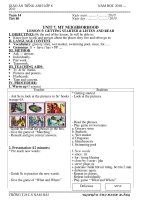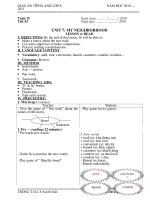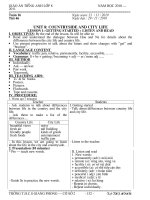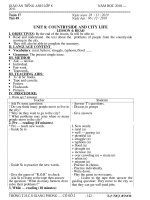GIAO AN TIENG ANH 8 TUAN 1 PPCT MOI NHAT THAI BINH
Bạn đang xem bản rút gọn của tài liệu. Xem và tải ngay bản đầy đủ của tài liệu tại đây (196.37 KB, 6 trang )
<span class='text_page_counter'>(1)</span><div class='page_container' data-page=1>
<b>Tuần 1</b>
<b>Tiết 1</b> <i>Ngày soạn: 07 / 08 /2010Ngày dạy :16 / 08 / 2010 </i>
<b>REVISION</b>
<b>I. Objectives:</b>
By the end of the lesson, students are able to practice some phrases about classroom
managements used during the years.
<b>II. Language content </b>
The simple past tense.
The present simple tense.
<b>III. Method: </b>Ask – answer.
<b>IV. Teaching aids:</b>
Some small pictures.
Ss’ books.
Posters.
<b>V. Procedure:</b>
<b>1. Prestation ( 8 </b>minutes)
Teacher Students
- Have Ss look at the pictures and describe
the activities.
+ What are these students doing?
+ Why do they do these activities?
+ Do you often do these activities in your
lesson?
- What tenses do you learn?
- Look at the pictures then answer.
+ They are standing up in the class.
+ They are greeting the teacher.
+ Yes, we are
- Tell the tenses they learned in grade 6 &
7.
<b>2. Practice ( 17 minutes)</b>
- Ask Ss to look at the sentences and tell
what tenses they are.
+ Lan and Nga are in grade 7 now.
+ We go to school in the morning.
+ They don’t go to school on Saturday.
+ My parents lived in Hue in 2007.
+ My father worked for a bank 5 years ago.
+ I was in class 7A last school year.
- Ask the Ss to answer the questions:
+ §éng tõ “To be” ë hiƯn tại có mấy dạng?
+ Động từ To be trong quá khứ có mấy
dạng?
+ Động tõ thêng ë th× qu¸ khø cã mÊy
d¹ng?
- Look at the poster and do the work
individually.
- Tell their ideas.
- Listen to the partners and remark.
- Answer teacher’s questions.
+ §éng tõ “ To be” ë hiƯn t¹i cã 3 d¹ng :
am, is, are.
+ Động từ To be ở quá khứ có 2 dạng:
was và were.
+ ng t thng thì q khứ có 2 dạng:
có quy tắc thêm “d/ ed”, dạng bất quy tắc
tra trong bảng động từ bất quy tắc cột 2.
<b>3. Production (15 minutes)</b>
- Guide ps to read these words a few times.
- Call some ps to read these words in front
- Look at the board and say loudly
following the teacher.
+ work in pairs : hoạt động cặp.
+ in groups : hoạt động nhóm.
+ stand up : đứng lên.
+ sit down : ngåi xuèng.
+ open your books : më s¸ch trang …
+ close your books : gấp sách vào.
+ listen to me : lắng nghe cô giáo nói.
+ keep silent : giữ trật tù.
</div>
<span class='text_page_counter'>(2)</span><div class='page_container' data-page=2>
of the class.
- Have Ss play a game: “Simon says”
- Remind Ss remember all the classroom
activities that will be used during the
lesson.
- Learn by heart the phrases words above.
- Play game of Simon says.
- Listen to the teacher.
- Write down in the notebooks.
<b>4. Homework ( 5 minutes)</b>
- Guides how to prepare period 2 – Unit 1- Getting started – Listen and read.
- Review how to describe the appearance of people.
- Read the Listen and read and fnd the new words, the strucuture.
<b>TuÇn 1</b>
<b>Tiết 2</b> <i>Ngày soạn: 11 / 08 /2010Ngày dạy : 18 / 08 / 2010 </i>
<b>Unit 1: My friends</b>
<b>Lesson 1 : Listen and read + Language focus 4 </b>
<b>I. Objectives:</b>
By the end of the lesson, students are able to ask and give information about someone.
Describe one’s favorite activities.
<b>II. Language content </b>
<b>Vocabulary: </b>seem, receive, next – door, photograph, enough, smile …..
<b>Grammar</b>: S + be (not) + adj + enough + to – V ….
<b>III. Method </b>
Communicative approach
Ask - answer.
<b>IV. Teaching aids: </b>
Pictures
Ss’ books.
Tape and cassette.
<b>V. Procedure:</b>
<b>1. Warm up ( 7</b> minutes)
Teacher Students
- Ask some questions:
+ Do you have any friends in other places?
+ What does she / he look like?
+ Where does he / she live?
+ How old is he/ she?
+ Which grade is he / she in?
+ Do you usually wri to each other?
- Answer T’s questions.
<b>2. Presentation ( 10 minutes)</b>
- Ask Ss to look at the picture and introduce
about it: This is Hoa and her friend who
lived next to Hoa’s house in Hue.
</div>
<span class='text_page_counter'>(3)</span><div class='page_container' data-page=3>
- Pre teach some new words.
- Guide Ss to read these words a few times.
- Call some Ss to read these words in front
of the class.
- Checking vocabulary by rub out and
remember.
- Các em sẽ đọc đoạn hội thoại giữa Lan và
Hoa về ngời hàng xóm của Hoa
I. New words:
- Show the new words they find from home.
+ To seem ( translation)
+ A next door neighbor ( explanation)
+ to look like ( translation)
+ smile ( miming )
+ photograph (real object )
- Listen to the T’s pronunciation.
- Repeat in chorus. ( 3 times)
- Repeat individually. ( 3 Ss).
- Play game “ Rub out and remember”.
- Prepare for listening.
<b>3. Practice (15 minutes) </b>
- Ask Ss to listen to the tape then tick T or F
for the following statements.
+ Lan and Hoa are talking about Nien.
+ Nien lives in Ha Noi now
- Please listen to the tape again then
practice with the partners.
- Call on some pairs to practice the dialogue
in front of the class. (4 pairs)
a) Where does Nien live?
b) Does Lan know Nien?
c) Which sentence tells you that Hoa is
older than Nien?
d) When is Nien going to visit Hoa?
II. Practice
- Listen to the tape then do the work.
+ T
+ F
- Practice the dialogue.
1. Practice the dialogue with a partner.
- Some pairs read the dialogue loudly.
Others listen to the partners and remark.
2. Answer the following questions:
+ She lives in Hue.
+ No, she doesn’t.
+ The sentence is: “She wasn’t old enough
to be in my class.”
+ At Christmas.
<b>4. Production (10 minutes)</b>
*Structure:
- Ask Ss to find out the new structure in the
dialogue.
- Nói đủ hoặc khơng đủ … để làm gì đó.
<b>S + be (not) + adj + enough + to V– …</b>
- Ask some Ss to take some more examples.
- Ask Ss to look at the exercise 1 (p.17 Ss’
books)
III. Structure
- She is not old enough to be in my class
- Write down the new structure.
Ex: Hoa is strong enough to lift this box.
I am old enough to be in grade 8.
They are tall enough to play volleyball.
Language focus 4:
<b>5. Home work (3 minutes)</b> :
Learn by heart vocabulary
Do exercise 1,2 (work book )
Guides how to prepare period 2 Read + Getting started.
<b>TuÇn 1</b>
</div>
<span class='text_page_counter'>(4)</span><div class='page_container' data-page=4>
<b>Unit 1: My friends</b>
<b>Lesson 2: GETTING STARTED + READ</b>
<b>I. Objectives: </b>By the end of the lesson students will be able to:
Review the structure how to describe someone’s appearance.
Understand the passage about Ba and his friends.
<b>II. Language content </b>
<b>Vocabulary</b>: character, orphanage, joke, sociable, generous, reserved, outgoing,
annoy, sense of humor.
<b>Grammar</b>: What do / does + S + look like?
S + be + adj.
<b>III. Method </b>
Communicative approach
Ask - answer.
Individually.
<b>IV. Teaching aids: </b>
Books and notebooks.
Posters and word cards.
Pictures.
Tape and cassette
<b>V. Procedure:</b>
<b>1. Warm up (7</b> minutes)
Teacher Students
- Ask Ss to look at the pictures on page 10
in Ss’ books.
- Points picture a) and asks Ss some
questions
+ What are these children doing?
+ Where are they?
+ Are they boys?
+ What do they look like?
- Describe the picture a): These boys are
tall and big with short hair. They enjoy
playing soccer.
- Ask Ss to work in pairs to do the same as
he example.
* Getting started: Describe these groups of
friends and their favorite activities.
- Look at the pictures
+ They are playing soccer.
+ They are in the stadium / ground/ park …
+ Yes, they are.
+ They are tall and big with short hair.
- Read the example.
- Write down.
- Work in pair to practice with other
pictures.
- Call some pairs to practice loudly in front
of the class.
- Ask Ss to describe each picture.
- Some pairs practice. Others listen to them
and remark.
b) The boys are at and short. They have
short hair. They enjoy playing chess.
</div>
<span class='text_page_counter'>(5)</span><div class='page_container' data-page=5>
C¸c em võa ôn tập lại cách miêu tả hình
dáng và së thÝch cña con ngêi. Trong bài
học hôm nay chúng ta tiếp tục nói về cách
miêu tả về tính cách của nhóm bạn th©n.
love reading books.
d) The girls are a little short with short hair.
They are interested in playing volleyball.
<b>2. Pre reading (–</b> 7 minutes)
- Ask Ss to look at the picture: This is Ba
and his three close friends: Bao, Khai and
Song.
- Ask Ss to listen to the tape with books and
find out the new words.
* Pre-teach vocabulary
- Have Ss read the words in chorus then ask
them to read again in front of the class.
- Checking by the game “Rub out and
remember”.
* T/F statements prediction:
- Set the scene: These statements are about
* Reading
- Show the new words in the text.
I. New words:
+ Character (explanation)
+ Orphanage (picture)
+ Reserved (explanation)
+ Sociable (explanation)
+ Tell jokes (example)
+ Sense of humor (explanation)
- Repeat in chorus.
- Repeat individually.
- Write down.
- Play game of “ Rub out and remember”.
- Read about Ba’s information on the poster.
a) Ba only has three friends: Bao, Khai and
Ba and his friends, read them and guess
which are true, which are false.
- Have Ss work in pairs.
- Call some Ss to give their answers.
Song.
b) Ba and his friends have the same
characters.
c) Bao, Song and Khai are quite reserved in
public.
d) They all enjoy school and study hard.
- Work in pairs.
- Some Ss tell their ideas.
3. While – reading ( 13 minutes)
- Ask the to read the text then compare with
their guessing, correct the answers.
* Multiple choice:
- Have Ss do the exercise 1 on page 14.
Guess Correct
a.
b.
c.
d.
</div>
<span class='text_page_counter'>(6)</span><div class='page_container' data-page=6>
- Ask them to work individually to choose
the best answer.
a) Ba talks about ... of his friends.
b) Bao’s volunteer work...
c) Khai and Song ...
d) Ba’s friends sometimes...his jokes.
- Call some Ss to tell their answers.
- Call some Ss to read the text loudly in
front of the class.
- Do the exercise individually.
* Choose the best answer.
- A. three B. all C. four D. none
- A. helps him make friends.
B. cause problems at exam time.
C. does not effect his school work
D. takes up a lot of time.
- A. like quiet place C. dislike school
B. don’t talk in public. D. enjoy sports
- A. answer B. do not listen to
C. laugh at D. get tired of
* Answer:
a) – A; b) – C ; c) – B ; d) – D
- Some Ss read the text loudly.
4. Post – reading (12 minutes)
* Comprehension questions
- Ask Ss to work in pairs to do exercise 2 on
page 14
a) How does Ba feel having a lot of friends?
b) Who is the most sociable?
c) Who like reading?
d) What is a bad thing about Ba’s jokes?
e) Where does Bao spend his free time?
- Have Ss practice in pairs: asking and
answering these questions.
- Translate the text into Vietnamese.
- Read the questions.
- Work in pairs.
a) He feel lucky having a lot of friends.
b) Bao is the most sociable
c) Khai likes reading.
d) His jokes sometimes annoy his friends.
e) Bao spends his free time doing volunteer
work at a local orphanage.
- Practice in pairs the questions loudly.
<b>5. Homework ( 2 minutes): </b>
Ask Ss learn by heart new words
Do exercise in text book.
</div>
<!--links-->









